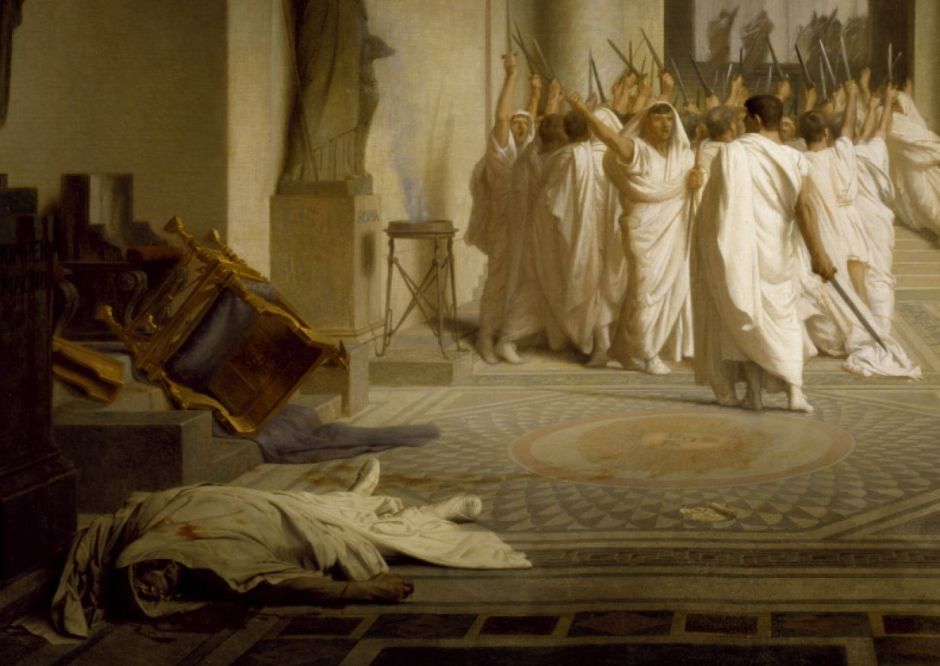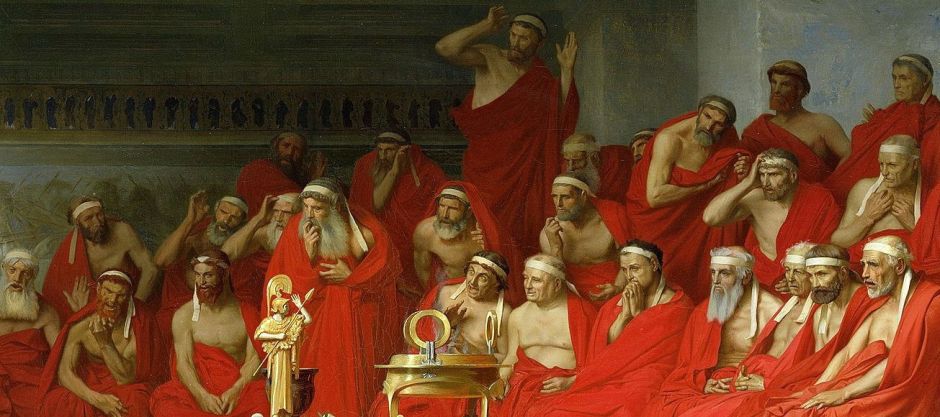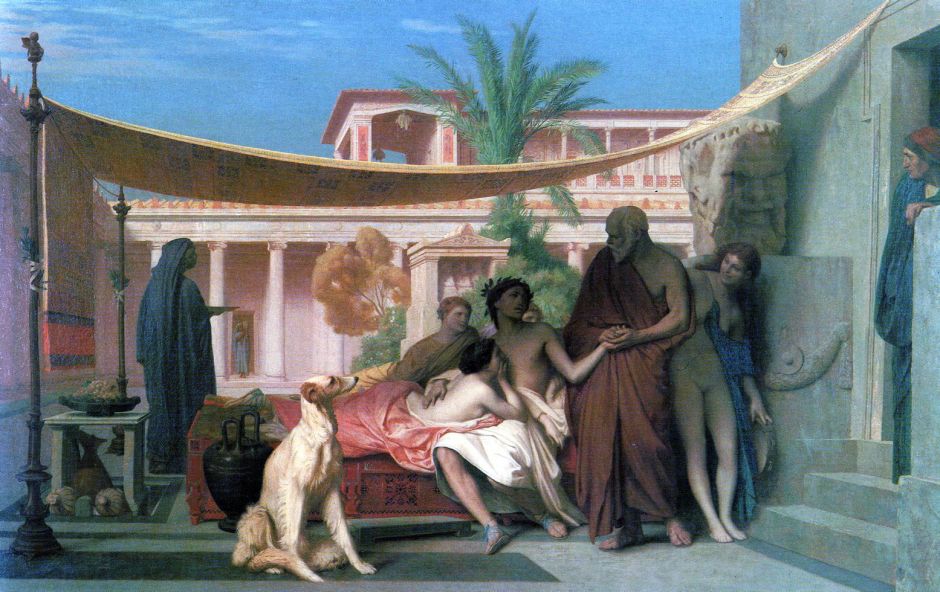The third of Jean-Léon Gérôme’s history paintings shown at the Salon of 1859 sadly vanished after being sold in 1951, and is now known only from a monochrome photograph which I have been unable to find as a usable image. It attracted the open praise of Charles Baudelaire, and revealed Gérôme’s novel approach to painted narrative.
Before looking at Gérôme’s depictions of the murder of Julius Caesar on the Ides of March 44 BCE, it’s worth looking at two other paintings of this well-known motif.

Vincenzo Camuccini’s The Assassination of Julius Caesar from 1804-05 follows the traditional model: the conspirators surround the beleaguered Caesar, brandishing their blades, about to stab him repeatedly. He looks directly ahead at his friend Brutus, uttering the words, “Et tu, Brute?” which were actually put in his mouth by William Shakespeare.

Karl von Piloty’s The Murder of Caesar from 1865, six years after the Salon in question, shows a slightly earlier moment, with Julius Caesar sat on a throne in the portico of the Senate. Immediately behind him, one of the conspirators has raised his dagger above his head, ready to strike the first blow.

In the image above, I have tried to give an impression of how Gérôme’s huge Caesar of 1859 might have looked, by editing a detail from his surviving Death of Caesar, from the same year. There were, of course, details of the empty section of the curia in the upper right, and its projection was slightly different. The graphite drawing below may bear some similarities, as it was produced as part of the preparatory work which the artist made for both paintings.

The surviving painting, The Death of Caesar (1859), is smaller in size and much wider in its view, including Caesar’s dead body, his departing murderers, even a senator sat far back at the right.

Both of Gérôme’s paintings of the dead Caesar are unusual because they show not the moments before his murder, nor the murder itself, but some moments afterwards. This defies conventional wisdom and Aristotle’s teaching of the importance of peripeteia.

Gérôme gives the obvious clue of Caesar’s body, almost concealed in his toga, with a bloodstain prominent on the upper chest. The chair on which he had been sat is overturned amid the chaos and violence of the attack. As the conspirators depart, their backs to the viewer, they are brandishing their blades in triumph above their heads.
Caesar’s bloody footprints lead down from the chair over towards the petition with which he had been presented by Lucius Tillius Cimber immediately before he was killed. It rests by a floor mosaic depicting the head of Medusa, the Gorgon who was beheaded by Perseus.

Far off at the right edge is a lone senator, still sitting in his place. Although it has been suggested that he was asleep, that doesn’t appear supported by his posture. A white cloak has been abandoned in haste on a seat close to the front, scrolls are scattered, and some who were not part of the conspiracy are hurriedly making away in the distance.
Gérôme provides all the evidence from which we can construct the story, much as might be done in a detective novel – a literary genre which started to become popular in Europe and North America in the first half of the nineteenth century, and became well-known with the publication of Edgar Allan Poe’s The Murders in the Rue Morgue in 1841.

The following year, Gérôme painted this contrasting portrait of Diogenes (1860), the Cynic who is reputed to have lived in a large storage jar or possibly a barrel as he attacked the conventional view. Surrounding him are four dogs, a delightful visual pun. The term cynic is derived from the Greek κυνικός (kynikos), meaning dog-like, the word which may be inscribed on the lantern that he is trying to light.
As has been explained:
There are four reasons why the Cynics are so named. First because of the indifference of their way of life, for they make a cult of indifference and, like dogs, eat and make love in public, go barefoot, and sleep in tubs and at crossroads. The second reason is that the dog is a shameless animal, and they make a cult of shamelessness, not as being beneath modesty, but as superior to it. The third reason is that the dog is a good guard, and they guard the tenets of their philosophy. The fourth reason is that the dog is a discriminating animal which can distinguish between its friends and enemies. So do they recognize as friends those who are suited to philosophy, and receive them kindly, while those unfitted they drive away, like dogs, by barking at them. (Wikipedia.)
Diogenes wasn’t exhibited at the Salon, but was sold in 1861 by Goupil’s London gallery for four thousand francs. I can’t help but wonder whether Gérôme saw himself as a Cynic.
In 1861-2, Gérôme painted three works which concern themselves with prostitution. It is worth remembering in this context that Manet completed his Le Déjeuner sur l’Herbe in 1863, usually read as depicting contemporary prostitution in Paris, which was refused by the Salon and exhibited in the Salon des Refusés that year.

Phryne was a highly successful and very rich courtesan (hetaira) in ancient Greece who, according to legend, was brought to trial for the serious crime of impiety. When it seemed inevitable that she would be found guilty, one of her lovers, the orator Hypereides, took on her defence. A key part of that was to unveil her naked in front of the court, in an attempt to surprise its members, impress them with the beauty of her body, and arouse a sense of pity. The legend claims that this ploy worked perfectly.

Phryne is to the left of the centre, in the midst of the semicircular court, completely naked apart from some jewellery on her neck and wrists, and her sandals. She is turned away from the gaze of the judges, her eyes hidden in the crook of her right elbow, as if in shame and modesty. Behind her (to the left), her defence has just removed her blue robes with a flourish, his hands holding them high.
At Phryne’s feet is a gold belt of a kind worn to designate courtesans in France from the thirteenth century, with the Greek word ΚΑΛΗ (kale), meaning beautiful.

The judges, all men with bare chests and wearing uniform scarlet robes, are taken aback. Gérôme shows a whole textbook of responses from pure fright, to anguish, grief, or disbelief, with each of those men looking straight at Phryne. The artist also follows an ancient colour coding scheme, in which the flesh of women is pale, almost white, in contrast to the more sallow skin of men.
Superficially, it is easy to suggest that Gérôme was using Phryne’s nakedness to appeal to the lowest desires, which remained one of the popular attractions of the annual Salon. However it is more likely that this is a statement about attitudes to the nude female form and the judgement of the Salon. The timing of Gérôme’s narrative moment is far more conventional, and conforms to Aristotle’s peripeteia and the novellist’s moment of surprise.
It was exhibited at the Salon of 1861, and at the Exposition Universelle in Paris in 1867, but critics like Émile Zola were harsh in their judgement, dismissing it as “antique rubbish”. Perhaps they also missed its compositional similarity to images of art students painting in a life class.

In his other narrative painting of that year, Gérôme told the story of a Greek statesman and general who in his youth used to sneak off and consort with courtesans: Socrates seeking Alcibiades in the house of Aspasia (1861). A pupil of Socrates, who appears to have had a pederastic relationship with the young Alcibiades, it was the philosopher who came and dragged his charge away from the clutches of Aspasia and her friends.
According to classical accounts, Alcibiades was so attracted to courtesans that he continued to enjoy their company after he married, which unsurprisingly led to his wife to try to divorce him.
Gérôme’s painting had been a commission for Sultan Abdul Aziz, and was exhibited in the Salon of 1861. Two years later, it was sold by Goupil for 12,500 francs.

A year later, it was a more contemporary story of Louis XIV and Molière (1862) which Gérôme committed to canvas. Jean-Baptiste Poquelin, universally known as Molière, was a highly successful playwright who enjoyed the patronage of King Louis XIV.
It is based on a story published in the memoirs of Madam Campan in 1822, in which Molière had been treated with disdain by the courtesans at the royal palace of Versailles. When the king heard about this, he invited the playwright to dine with him, which would impress the court and enhance Molière’s credibility with the courtesans.
Although an apocryphal story of dubious merit, this had been painted by Ingres in 1857. Gérôme’s purpose seems to have been for the greater glory of the Emperor Napoleon III. This painting was exhibited at the Salon in 1863, and sold by Goupil from there for 25,000 francs. It was later exhibited at the Exposition Universelle in Paris in 1867, by which time it was already in American ownership. In 1923, it was bought by William Randolph Hearst.
Over a period of just three years, from Caesar (1859) to Louis XIV and Molière (1862), Gérôme had swung from the staidly conventional to the highly novel, and had covered the themes of assassination, cynicism, prostitution, and looking. He was at the height of his narrative powers just as the Second Empire was about to turn sour.
References
Ackerman GM (2000) Jean-Léon Gérôme, Monographie révisée, Catalogue Raisonné Mis à Jour, (in French) ACR Édition. ISBN 978 2 867 70137 5.
Scott Allan and Mary Morton, eds. (2010) Reconsidering Gérôme, Getty. ISBN 978 1 6060 6038 4.
Gülru Çakmak (2017) Jean-Léon Gérôme and the Crisis of History Painting in the 1850s, Liverpool UP. ISBN 978 1 78694 067 4.
de Cars L et al. (2010) The Spectacular Art of Jean-Léon Gérôme (1824-1904), Skira. ISBN 978 8 85 720702 5.

